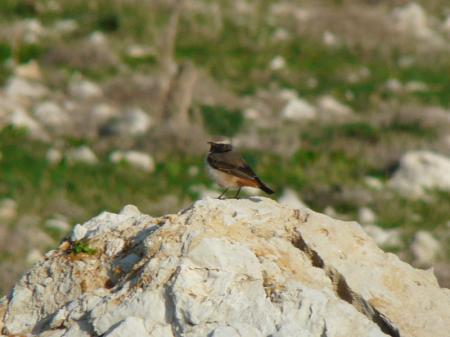Geographically, Cyprus is caught between the Western and Central Paleo-arctic. And we get all sorts of vagrants it seems, especially in winter. Last winter in particular was surprising with a Baird’s Sandpiper and a Pectoral Sandpiper, that must’ve gotten just a bit lost.
This winter is equally interesting, although the vagrants seem to be coming from the Middle East, for the most part.
The first was the Steppe Grey Shrike, which is usually considered a subspecies of Southern Grey Shrike and typically breeds in Central Asia and winters in Iran and further eastwards. Remarkably, it seems to be staying around for most of the winter so far, enjoying weather that’s warm enough to let small lizards remain active (Shrikes need to eat too).
The second was the Grey Hypocolius, and typically resides in Iraq and Iran, rarely straying outside of the states neighboring the Persian Gulf. This birds didn’t stick around more than 2 days and eluded all but the quicker twitchers.
And now we have a Kurdish Wheatear to speak of. As its name suggests, it’s typically from the Kurdish or Kurdistan regions of Eastern Turkey, Northern Iraq, and neighboring countries, and is alternatively called Kurdistan Wheatear or Red-rumped Wheatear, and is not to be confused with the Persian Wheatear with which it was formerly lumped as a species with. There’s no telling how long it’s been here, because unlike the first two this one was found in a place in Cape Greco that is virtually ignored by birders as being virtually vacant of birds. Thus the Kurdish Wheatear could’ve been there for over a month with no one recognizing it.
The Steppe Grey Shrike and Kurdish Wheatear were each only the 5th (or so) record for Cyprus, while the Grey Hypocolius was a first record for Cyprus (and for Europe, in fact).
And oh yeah, there’ve been a couple other interesting vagrants not from the Mid East too. Like the Red-breasted Mergansers see at Paralimni a few days ago. They used to winter here in small numbers on occasion, but are still extremely rare visitors.
Why the trend though, in the ultra-rare birds coming from the Mid East this year? That’s the puzzle, I think. The conventional wisdom though is that weather and more specifically the warm/cold fronts can “push” or blow the birds outside of their usual ranges. This, I think, explains a lot of why it seems to happen from a specific region in a specific year, and another region in another year, etc. And of course it’s also true that some species will wander in search of food bonanzas to one degree or another. But taking the long view, in light of the role of geographical dispersion in evolution, I can’t help but think that there’s a slim but real chance that a few of these vagrants could potentially form a founder population.
Unlikely, I know, but it probably happens once in a great long while if you think about it.
CREDIT: ©Jane Stylianou / Cyprus Bird Tours





 New writers welcome – please contact us for details.
New writers welcome – please contact us for details.

















Dan, these are great birds. Out of interest are there more birders out scouring Cyprus than ever before?
Hi Charlie,
Good question! Yes, it is my general impression that there is at least a small but consistent increase in the number of birders, or at least those reporting their sightings. Also good news is that in the last few years there’ve been a Cypriot here and there who’s gotten more interested in birding.
Hi Dan
We have a small villa in south Cyprus and would love to know
Are there any humming birds or humming bird Moths in the South of Cyprus?
Also what foods would attract the smaller bird life. Many Thanks Vic
Hi Vic,
Hummingbirds are endemic to (only found in) the Americas, but Hummingbird Moths can be seen in Europe. I’m not an expert on them, but a quick search brings this to my attention:
That’s apparently from the field guide The Hawkmoths of the Western Palaearctic.
For attracting birds, sunflower seeds are recommended for finches and sparrows, while you’ll want berries or mealworms for other small birds. Anywhere you find bird feeders, either on the web or in stores, you should be able to find info about wild bird food – but stores with bird feeders in stock are virtually non-existent in Cyprus.
I hope that helps!
Next saturday 22-12-12 i will be birding on Cyprus for a week. I am really looking forward to the experience. I will be visiting Northern Cyprus to bird around Kyrenia and the Karpaz. A local biologist has agreed to show me the sites. Any suggestions are more than welcome. I will be carrying my nikon D90 with 500mm lense hoping to catch some beauty. I have contacted Jane but she is in the southern Greek part which is not freeky accessible for the Northerns and vice versa. I want to see the Geiers, Eagles, Francolins, a late Cyprus warbler and Gulls and hope to encounter many vagrants or hang-around species.